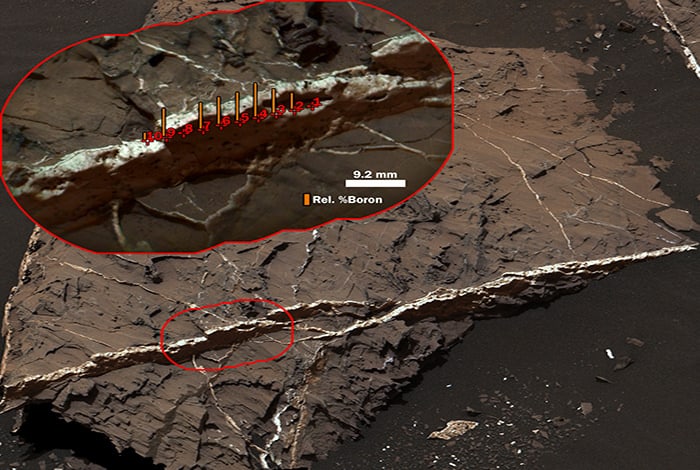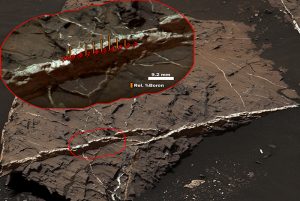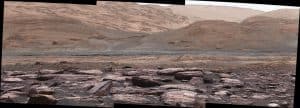
 Boron has been identified for the first time on the surface of Mars, indicating the potential for long-term habitable groundwater in the ancient past.
Boron has been identified for the first time on the surface of Mars, indicating the potential for long-term habitable groundwater in the ancient past.
“No prior mission to Mars has found boron,” said Patrick Gasda, a postdoctoral researcher at Los Alamos National Laboratory. “If the boron that we found in calcium sulfate mineral veins on Mars is similar to what we see on Earth, it would indicate that the groundwater of ancient Mars that formed these veins would have been 32-140 degrees Fahrenheit and neutral-to-alkaline pH.” The temperature, pH, and dissolved mineral content of the groundwater could make it habitable.
The boron was identified by the rover’s laser-shooting Chemistry and Camera (ChemCam) instrument, which was developed at Los Alamos National Laboratory in conjunction with the French space agency.
Boron is famously associated with arid sites where much water has evaporated away—think of the borax that mule teams once hauled from Death Valley. However, environmental implications of the boron found by Curiosity are still open to debate.
As the rover has progressed uphill, compositions trend toward more clay and more boron. These and other variations can tell us about conditions under which sediments were initially deposited and about how later groundwater moving through the accumulated layers altered and transported ingredients.
Groundwater and chemicals dissolved in it that appeared later on Mars left its effects most clearly in mineral veins that filled cracks in older layered rock. But it also affected the composition of that rock matrix surrounding the veins, and the fluid was in turn affected by the rock.
“There is so much variability in the composition at different elevations, we’ve hit a jackpot,” said John  Grotzinger, of Caltech. As the rover gets further uphill, researchers are impressed by the complexity of the lake environments when clay-bearing sediments were being deposited and also by the complexity of the groundwater interactions after the sediments were buried.
Grotzinger, of Caltech. As the rover gets further uphill, researchers are impressed by the complexity of the lake environments when clay-bearing sediments were being deposited and also by the complexity of the groundwater interactions after the sediments were buried.
“A sedimentary basin such as this is a chemical reactor,” Grotzinger said. “Elements get rearranged. New minerals form and old ones dissolve. Electrons get redistributed. On Earth, these reactions support life.”
Whether Martian life has ever existed is still unknown. No compelling evidence for it has been found. When Curiosity landed in Mars’ Gale Crater in 2012, the mission’s main goal was to determine whether the area ever offered an environment favorable for microbes.
Four recent drilling sites, from “Oudam” this past June through “Sebina” in October, are spaced about 80 feet apart in elevation. This uphill pattern allows the science team to sample progressively younger layers that reveal Mount Sharp’s ancient environmental history.
“Variations in these minerals and elements indicate a dynamic system,” Grotzinger said. “They interact with groundwater as well as surface water. The water influences the chemistry of the clays, but the composition of the water also changes. We are seeing chemical complexity indicating a long, interactive history with the water. The more complicated the chemistry is, the better it is for habitability. The boron and clay underline the mobility of elements and electrons, and that is good for life.”


Be the first to comment